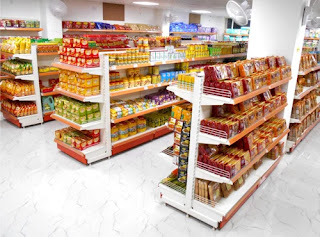Supermarket Racks
Supermarket Racks, also known as display racks or shelving systems, are essential fixtures used in retail environments like supermarkets and grocery stores to organize and showcase a wide range of products. These racks are designed to efficiently utilize space, enhance product visibility, and make the shopping experience more convenient for customers.
Here are some common types of supermarket racks:
Gondola Racks: Gondola racks are the most common type of shelving used in supermarkets. They consist of freestanding units with adjustable shelves on both sides, creating aisles for product display. Gondola racks are versatile and can be customized to fit different product categories.
Wall Shelving: Wall shelving units are attached to the store walls, optimizing vertical space for displaying items such as packaged goods, personal care products, and household items.
End Cap Displays: Positioned at the end of aisles, end cap displays are prime locations for highlighting promotional or high-margin products. They capture customer attention and encourage impulse purchases.
Island Racks: Island racks are standalone structures placed throughout the store to create distinct product sections. They can hold items like clothing, electronics, seasonal products, and more.
Bulk Bin Racks: Bulk bin racks are designed for selling loose or bulk items such as grains, nuts, dried fruits, and candies. They often include containers that customers can use to scoop out the desired amount.
Produce Displays: These racks are designed to present fruits and vegetables attractively. They typically feature angled shelves, trays, and bins that allow proper airflow and visibility for perishable items.
Bakery Racks: Bakery racks are used to showcase baked goods like bread, pastries, and cakes. They can include shelves, hooks, and compartments to accommodate various bakery products.
Refrigerated and Freezer Displays: Equipped with cooling or freezing mechanisms, these racks are used to store and display perishable items like dairy products, meat, and frozen foods.
When selecting supermarket racks, considerations include the types of products to be displayed, the store's layout, available space, and customer traffic patterns. Durability, adjustability, and ease of maintenance are also important factors to ensure the longevity and functionality of the racks. Modern supermarkets may also incorporate technology, such as digital signage and interactive displays, to enhance the shopping experience and provide additional information about products.

.jpg)

.jpg)
Comments
Post a Comment